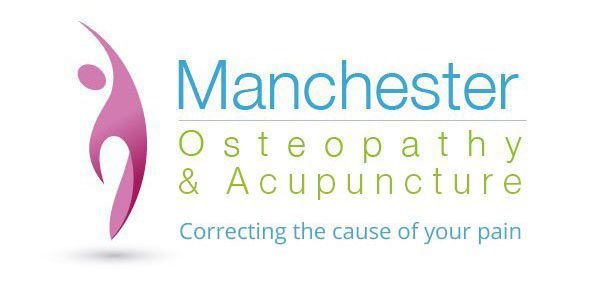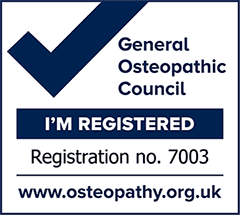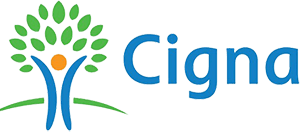Relieving your Low Back pain, correcting the cause of your pain
It’s important to appreciate that pain is your body’s way of letting you know something is wrong; an injury has occurred. Unfortunately, this gets lost in today's modern society, where people are encouraged to take painkillers. This approach simply masks the pain. It doesn't consider or correct the injury or what caused it. At Manchester Osteopathy, we diagnose and treat the structures of the body the injury has occurred in, fix any postural issues relating to the injury, and give any necessary lifestyle/exercise advice.
Understanding low back pain and why it occurs
Posture
Poor posture greatly increases the likelihood of someone developing low back pain. The two images below show how two compromised postural patterns caused by muscle imbalances affect the 23 facet joints on either side of the spine, the healthy curves of the spine, and how a knock-on effect compromises the pelvis, hips, knees, and ankles.
A misaligned pelvis and compromised curves in the spine will result in your upper body weight going unevenly into the low back. This uneven loading of the weight-bearing joints of the spine is one of the most common causes of low back pain.

Muscle imbalances causing the right hip to raise resulting in a scoliosis.
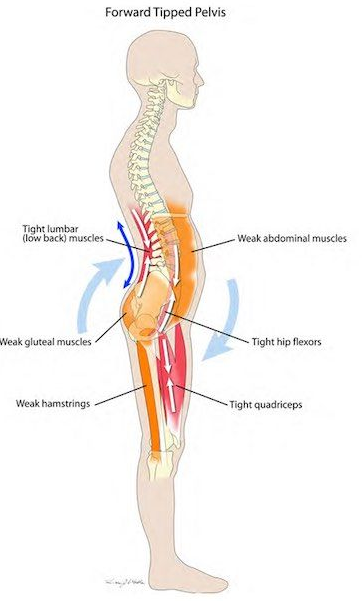
Tight hip flexors causing an excessive curve
in the low back.
How structures in the low back become strained and injured
The most common injuries to the lower back are muscle strains, ligament sprains, facet joint surface (cartilage) wear and tear, and disc herniation/prolapses. Most of the time, these structures become injured when carrying out their functions. Below we've described the job these structures carry out and how the injury happens.
Muscle injuries
The function of all muscles is to create joint movement. They achieve this by contracting and relaxing either side of the joint they cross. If this occurs while you are handling a load that is too heavy, carried out too repetitively, or done after assuming an awkward compromised posture, it can result in muscles straining or tearing.
A common action that causes muscle injuries in the low back is forward bending with the legs straight. This movement isolates the small weak muscles that cross the Lumbar spine (the low back) to carry out the task. Resulting in the low back having to lift/take the weight of the upper body and the load. The weight of the average adult's upper body in the UK is around eight stone / 50kg. It also places the low back muscles on stretch before they contract, significantly increasing the likelihood of a muscle injury.

Trigger points
To make things even more complicated, the area of the body the pain is experienced in might not be the same as the muscles that are strained/causing the pain. This is because trigger points can form in muscles that have become injured, and trigger points can refer to pain in other areas of the body. Mark has written a thesis on Trigger points and has a thorough understanding of the location of the most common trigger points and the area of the body they refer to.
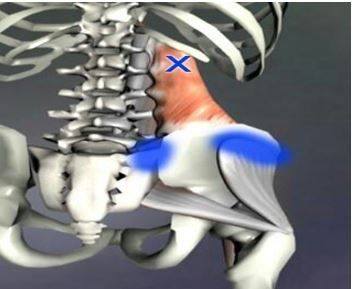
The X mark in the Quadratus Lumborum muscle shows the location of the trigger point, and the area shaded in blue indicates where the discomfort is felt.
Ligament injuries
Ligaments hold bone to bone. Their function is to give joints stability and prevent excessive movement. Maintaining their original tone and strength is essential for all ligaments in the body to do this job effectively. Taking any joint past its healthy elastic limit repetitively can result in ligaments losing their tone and strength, as can the effects of a traumatic injury such as whiplash. Forward bending and rotating the spine to one side greatly increases the likelihood of this injury occurring in the low back, especially to the Iliolumbar ligament (highlighted below) that attaches from the pelvis to the spine. The Illiolumbar ligament is on both sides of the spine; the injury would occur to the side you had been rotating away from.
Long-term ligament instability also dramatically increases the potential for muscle strains. To compensate for ligament sprains and subsequent joint instability, the body increases the tone of the muscles crossing the same joint creating a substitute barrier. This, unfortunately, has consequences as it dramatically increases the likelihood of those muscles straining. Muscles going into a protective / substitute spasm, especially if only on one side of the body, can also affect posture and cause other long-term adverse effects, such as the poor postures described above.
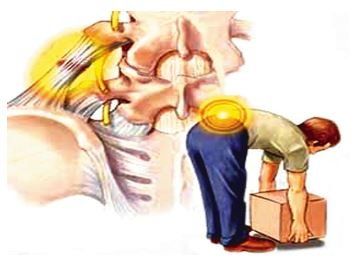
Disc injuries
Spinal discs carry out three essential roles. They act as cartilage separating the bones of the spine; they act as shock absorbers and also allow movement to pass through them. It is when movement or compressive forces pass through a disc that injury occurs. Discs don’t slip; they bulge and then tear if continually loaded unevenly. This can happen as a result of traumatic injury; however, most of the time, this occurs because the sufferer has assumed a poor posture repetitively over a long period.
It isn’t just physical activity or trauma that causes a disc injury; sitting in a poor posture can contribute to a disc injury in the low back. The Human body isn't designed to sit for 8 to 10 hours, as so many of us now have to. If the spine is kept in the neutral position (healthy spinal alignment is a subtle S shape) and all 23 discs share the upper body's weight, this greatly reduces the chance of disc injury. However, a compromised spine greatly increases the likelihood of a disc injury. The last 3 or 4 discs in the low back take the compressive force of our upper body weight, and anything we lift, carry, or handle increases the risk. The diagram below highlights how sloughing in a chair causes the spine to lose its healthy S shape and cause an unhealthy C-shaped curve.
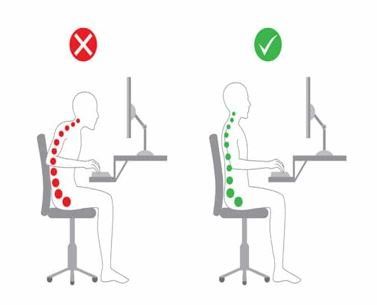
A large C curve results in the discs in the low back being compressed more at the front, whereas an aligned / straight spine places the compressive force through the entire disc. If the disc is compressed at the front repetitively or for long periods, it will initially cause low-level back pain as the disc's tissues are strained. This tells you you need to change your habits and seek professional help.
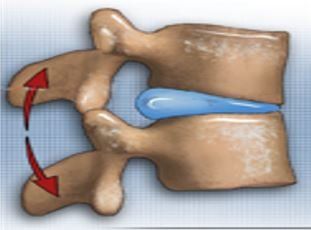
If the early warning symptoms of pain are ignored, it can lead to the disc bulging & eventually tearing. This can result in nerve root or even spinal cord compression.
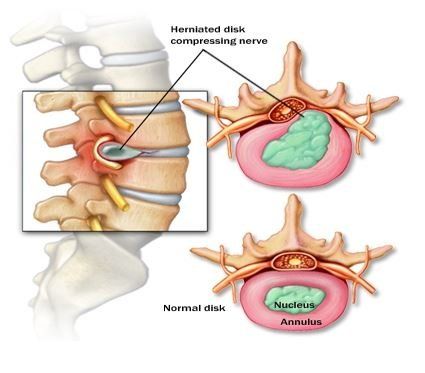
How can Mark help?
As a trained Osteopath, Mark diagnoses and treats the structure in the body causing the pain and the postural pattern contributing to the problem and will give advise regarding the activities/lifestyle factors causing your back pain. This approach not only relieves the symptoms but also helps to prevent other conditions from becoming a problem.
If you need treatment for low back pain, contact Manchester Osteopathy.
0161 270 0426 or 07976 254 439

